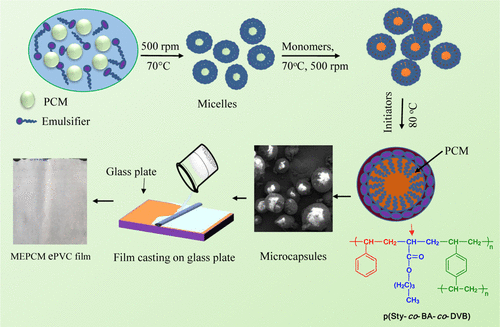当前位置:
X-MOL 学术
›
Energy Fuels
›
论文详情
Our official English website, www.x-mol.net, welcomes your
feedback! (Note: you will need to create a separate account there.)
Facile Synthesis of Microencapsulated 1-Dodecanol (PCM) for Thermal Energy Storage and Thermal Buffering Ability in Embedded PVC Film
Energy & Fuels ( IF 5.2 ) Pub Date : 2020-06-11 , DOI: 10.1021/acs.energyfuels.0c01019 Jitendra Singh 1 , Sumit Parvate 1 , Prakhar Dixit 1 , Sujay Chattopadhyay 1
Energy & Fuels ( IF 5.2 ) Pub Date : 2020-06-11 , DOI: 10.1021/acs.energyfuels.0c01019 Jitendra Singh 1 , Sumit Parvate 1 , Prakhar Dixit 1 , Sujay Chattopadhyay 1
Affiliation

|
Microencapsulation of lauryl alcohol (1-dodecanol; mp, 22 ± 0.3 °C; melting enthalpy, 191 ± 3 J/g), a renewable phase change material (PCM), was carried out using copolymer shell [poly(styrene-co-n-butyl acrylate-co-divinylbenzene) or p(Sty-co-BA-co-DVB)] synthesized adopting emulsion polymerization. The thermal buffering ability of microencapsulated phase change material (MEPCM) was evaluated after embedding these capsules in a poly(vinyl chloride) (PVC) film. Spectroscopic (FT-IR) and morphological characterization of MEPCM capsules and MEPCM-embedded PVC film (MEPCM ePVC) confirmed the formation of core–shell microstructure with just physical interaction between PCM and shell. Differential scanning calorimetry (DSC) measurements confirmed effective encapsulation of core inside the p(Sty-co-BA-co-DVB) shell, and the latent heat of melting of capsules was in the range between 94 ± 3 and 133 ± 3 J/g. Thermogravimetric analysis (TGA) measurements supported the data of PCM content measured from DSC. A polarized optical microscope with hot stage established nonleaking behavior with MEPCM ePVC when exposed to 50 °C. The thermal buffering ability of the MEPCM ePVC film was demonstrated based on 41.9 and 224.8% delays in temperature change during charging and discharging steps, respectively, compared to the performance with pristine PVC film wrapped over a box of specific dimension.
中文翻译:

微胶囊化1-十二烷醇(PCM)的简便合成,用于嵌入式PVC膜中的热能存储和热缓冲能力
月桂醇的微囊化(1-十二醇;熔点,22±0.3℃;熔化焓,191±3焦耳/克),可再生的相变材料(PCM),进行了使用共聚物壳[聚(苯乙烯-共-丙烯酸正丁酯-co-二乙烯基苯)或p(Sty- co -BA- co-DVB)]采用乳液聚合法合成。将这些胶囊嵌入聚氯乙烯(PVC)薄膜中后,评估了微胶囊相变材料(MEPCM)的热缓冲能力。MEPCM胶囊和MEPCM包埋的PVC膜(MEPCM ePVC)的光谱(FT-IR)和形态学特征证实了核壳结构的形成,而PCM和壳之间只有物理相互作用。差示扫描量热法(DSC)测量证实p(Sty- co -BA- co-DVB)外壳,胶囊熔化的潜热在94±3和133±3 J / g之间。热重分析(TGA)测量支持从DSC测量的PCM含量数据。当暴露于50°C时,带有热台的偏振光学显微镜可通过MEPCM ePVC建立无泄漏行为。与分别包装在特定尺寸的盒子上的原始PVC薄膜的性能相比,分别基于41.9%和224.8%的温度变化在充放电步骤中的延迟,证明了MEPCM ePVC薄膜的热缓冲能力。
更新日期:2020-07-16
中文翻译:

微胶囊化1-十二烷醇(PCM)的简便合成,用于嵌入式PVC膜中的热能存储和热缓冲能力
月桂醇的微囊化(1-十二醇;熔点,22±0.3℃;熔化焓,191±3焦耳/克),可再生的相变材料(PCM),进行了使用共聚物壳[聚(苯乙烯-共-丙烯酸正丁酯-co-二乙烯基苯)或p(Sty- co -BA- co-DVB)]采用乳液聚合法合成。将这些胶囊嵌入聚氯乙烯(PVC)薄膜中后,评估了微胶囊相变材料(MEPCM)的热缓冲能力。MEPCM胶囊和MEPCM包埋的PVC膜(MEPCM ePVC)的光谱(FT-IR)和形态学特征证实了核壳结构的形成,而PCM和壳之间只有物理相互作用。差示扫描量热法(DSC)测量证实p(Sty- co -BA- co-DVB)外壳,胶囊熔化的潜热在94±3和133±3 J / g之间。热重分析(TGA)测量支持从DSC测量的PCM含量数据。当暴露于50°C时,带有热台的偏振光学显微镜可通过MEPCM ePVC建立无泄漏行为。与分别包装在特定尺寸的盒子上的原始PVC薄膜的性能相比,分别基于41.9%和224.8%的温度变化在充放电步骤中的延迟,证明了MEPCM ePVC薄膜的热缓冲能力。











































 京公网安备 11010802027423号
京公网安备 11010802027423号